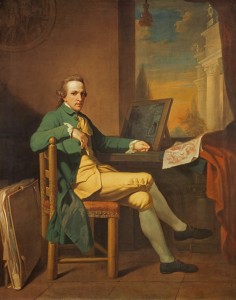The Foulis Academy’s Famous Pupils: David Allan (1744-96), “The Scottish Hogarth”
David Allan, Self Portrait, Royal Scottish Academy of Art and Architecture, Edinburgh.
David Allan was born in Alloa, and began his studies at the Foulis Academy when he was eleven years old. He left in 1762. Allan became a portrait and genre painter, and has been called the “Scottish Hogarth”. His links with the Foulis family were maintained when he provided the aquatint illustrations for Allan Ramsay’s The Gentle Shepherd: A Pastoral Comedy, which was published by Robert Foulis’s son, Andrew, in 1788. Glasgow University Library owns a copy with Allan’s pencil drawings for the illustrations.
As noted elsewhere on this site, in his article, A Scottish Catalyst: The Paintings of David Allan, Basil Skinner comments “To label David Allan with such epithets as ‘the Scottish Hogarth’ or ‘the Scottish Zoffany,’ is completely to misunderstand his contribution to the development of painting in Scotland. Allan was no mere stylistic copyist, neither was he simply a follower of other artists’ successful fashions. He was an experimenter, an explorer in the subject matter of paint, and as such his influence on the development of painting modes in Scotland in the late 18th century was above all that of a catalyst”.
Skinner also stated:
“Allan worked in the generation between Ramsay and Raeburn. His training in art and his subsequent career are interesting in one respect because of his involvement with two of the academies of art that flourished in Scotland at the time. As a young man he studied for a period at the academy founded by the Foulis brothers in Glasgow in the 1750s, and this academy, modelled closely upon the great teaching-schools of Rome, stood alone in Scotland in providing a sophisticated and thorough grounding in the fine arts. It was also, incidentally, alone in Britain at this time in providing funds for its most promising students to carry forward their studies into Italy, and this antedates the Royal Academy’s travelling scholarships by some years. Allan was thus one of a comparatively small number of Scottish painters who had the advantage of this formal education in art before their Italian years, instead of the traditional but more chancy system of training by apprenticeship.”
For further information, see: George Fairfull-Smith, The Foulis Press and The Foulis Academy: Glasgow’s Eighteenth-Century School of Art and Design, 2001.
www.basilskinner.com for the article on David Allan, and also Basil Skinner, The Indefatigable Mr Allan, 1973.
George Fairfull-Smith, September 2020.

